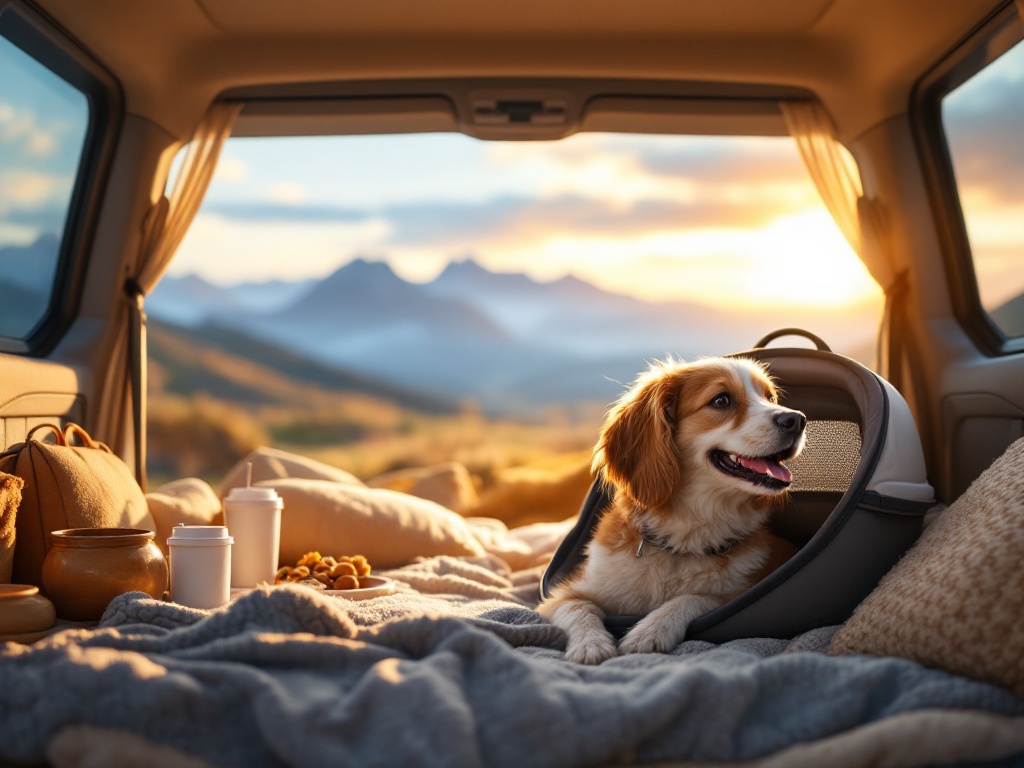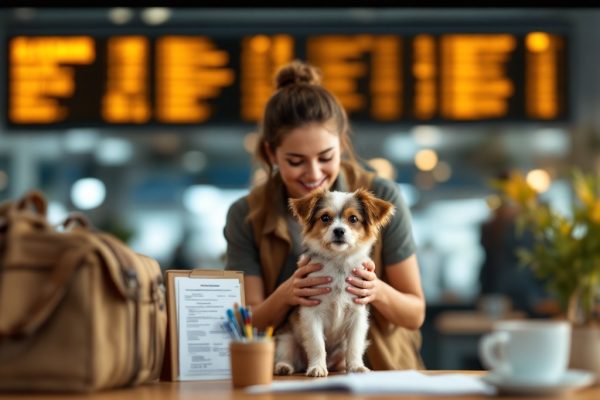How to Plan Ahead for What to Do with Pets When Traveling
Traveling with your beloved pet? Careful planning ensures a smooth, enjoyable adventure for both of you. Discover essential tips for preparing your pet for travel, from choosing the right transportation and accommodations to packing a comprehensive travel kit and handling emergencies. Learn how to minimize travel stress and maximize your pet’s comfort and safety. Start planning your pet-friendly getaway today!
Important information

- Consult your vet: Schedule a pre-trip checkup to ensure your pet is healthy enough for travel, discuss necessary vaccinations and medications, obtain required travel documents, and address potential health risks at your destination.
- Research and prepare: Investigate pet-friendly accommodations, transportation, and activities. Pack a comprehensive travel kit with food, water, medications, comfort items, a first-aid kit, and essential documents.
- Choose appropriate transportation: Consider your pet’s needs and research airline or other transport regulations. Secure your pet safely during car travel and plan for regular breaks.
- Acclimate your pet: Gradually introduce your pet to their carrier and take short car rides before the trip to reduce travel anxiety. Pack familiar items and consider calming pheromone sprays.
- Plan for emergencies: Research emergency veterinary services at your destination. Ensure your pet has proper identification, including a microchip and up-to-date tags. Prepare a backup plan for unexpected travel disruptions.
Understanding the Importance of Planning Ahead for Pets When Traveling
Traveling with your pet can be a wonderful experience with a little preparation. Consider your pet’s individual needs, such as their preferred food and any anxieties they might have. Think about your mode of transportation—car, plane, or train—as each has unique requirements. Research pet-friendly accommodations, transportation options, and activities at your destination. A well-stocked travel kit is essential. Pack food, water, medications, and familiar comfort items. Consult your veterinarian about necessary vaccinations and health certificates. By planning ahead, you and your furry companion can enjoy a safe and pleasant trip.
Consider your pet’s individual needs, such as their preferred food, any anxieties they might have, and their comfort level with different modes of travel.
Determine your mode of transportation (car, plane, or train) and research the specific pet policies and requirements for each.
Research pet-friendly accommodations, transportation options, and activities at your destination to ensure a smooth and enjoyable experience.
Prepare a well-stocked travel kit including food, water, medications, bowls, leash, waste bags, and familiar comfort items like their favorite toy or blanket.
Consult your veterinarian about necessary vaccinations, health certificates, and any specific health concerns related to your pet’s travel.
Assessing Your Pet’s Needs Before Traveling
Before traveling with your pet, assess their health, behavior, and comfort level in a crate. A pre-travel veterinary checkup will confirm their fitness for travel and ensure they are healthy enough for the adventure.
Evaluate Your Pet’s Health and Behavior
Monitor your pet closely for any signs of stress or discomfort. A pre-trip veterinary checkup is recommended to address potential health issues and ensure they are fit for travel.
Consult a Veterinarian for a Pre-Travel Checkup
A pre-trip vet checkup is vital for your pet’s travel safety. This visit confirms their fitness to travel and allows you to discuss necessary vaccinations and medications with your veterinarian. You can also obtain the correct travel documents and address any potential health risks specific to your destination, such as higher incidences of certain diseases. By preparing proactively, you can minimize these risks and ensure a healthy, happy journey for your companion. Here’s what you should discuss with your vet:
Confirm your pet’s fitness to travel. Your vet will assess their overall health and determine if they are fit for the journey.
Discuss necessary vaccinations and medications. Ensure your pet is up-to-date on all required vaccinations and discuss any necessary preventative medications for your destination.
Obtain the correct travel documents. Your vet can provide the necessary health certificates and other travel documents required by your destination.
Address potential health risks. Discuss any potential health risks specific to your destination, such as parasites or diseases, and how to protect your pet.
Ensure Proper Identification and Tags
For a smooth pet travel experience, ensure your furry friend has both an ID tag and a microchip. A collar tag displaying your contact details and your destination’s address is crucial. This simple step can quickly reunite you with your pet if they happen to wander off.
Exploring Options for Pet Care While You’re Away
Choosing the right pet care is crucial for your pet’s happiness and comfort while you’re away. Here’s a breakdown of popular options:
Professional Pet Sitters
Pet sitters offer personalized care in the comfort of your home. They visit regularly to feed, play with, and care for your pet, allowing them to stay in their familiar environment, reducing stress and anxiety. This option is ideal for pets who thrive in their own space and prefer individual attention.
Boarding Facilities
Boarding facilities provide 24/7 care from trained staff. Amenities often include play areas and socialization opportunities. However, the unfamiliar environment can be stressful for some pets. This is a suitable option for social pets who enjoy the company of other animals and don’t mind a change of scenery.
Family or Friends
Asking family or friends to care for your pet offers a personal touch and can be a cost-effective solution. However, this depends on their availability, pet-care experience, and your pet’s compatibility with them. This option works best if your pet is comfortable with the caregiver and their environment.
Making the Right Choice
Consider your pet’s personality, needs, and the duration of your trip to make the best decision. For anxious pets, in-home care is often the best choice. Social butterflies might enjoy a boarding facility. If your trip is short, a trusted friend or family member could be ideal. Choosing wisely ensures a happy pet and a worry-free trip for you.
Hiring Professional Pet Sitters
Hiring a professional pet sitter can keep your pets happy and stress-free while you’re away. Forget kennels and ask friends, family, or your veterinarian for recommendations. Online platforms also offer various pet care services. Interview potential sitters and check their references. Trust your instincts, and always provide detailed information about your pet’s needs, routines, and health for optimal care.
Considering Boarding Facilities
Choosing the right boarding facility for your pet involves careful consideration of several key factors. Reputation and services are paramount, research reviews and testimonials to understand the facility’s track record. Consider a facility with an on-site or nearby veterinary clinic if your pet has specific medical needs. Cleanliness is crucial for your pet’s health, so ensure the facility maintains high hygiene standards. The staff’s experience and compassion are essential for your pet’s well-being, observe how they interact with animals to assess their level of care. Vaccination policies should align with your pet’s health records, confirm their requirements beforehand. Inquire about exercise opportunities and socialization programs to ensure your pet’s physical and mental stimulation during their stay. Understanding the facility’s emergency procedures will provide you with peace of mind in unforeseen situations.
Asking Family or Friends to House Sit
Leaving your pet with family or friends offers several advantages. The familiar surroundings can reduce anxiety, especially for timid or special needs pets. Maintaining their established routine, including meals, playtime, and walks, minimizes the disruption of unfamiliar environments like boarding kennels. Clear communication is essential. Before you leave, discuss detailed care instructions and provide emergency contact information. This will ensure your pet’s safety and well-being.
Researching Pet-Friendly Destinations and Accommodations
Finding pet-friendly places is easy with online tools and apps like BringFido, PetsWelcome, and GoPetFriendly. These resources offer comprehensive directories of pet-friendly hotels, restaurants, parks, and more. They also provide valuable information such as reviews, ratings, and pet policies, including any fees or restrictions. Always confirm these details directly with the hotel or rental property before booking, as policies and fees can change. This ensures a smooth and enjoyable trip with your furry friend.
Utilizing Online Tools and Apps for Pet-Friendly Locations
Planning a trip with your pet? Websites like BringFido, PetsWelcome, and GoPetFriendly can simplify your travel planning. These resources help you find pet-friendly hotels, restaurants, parks, and other services, complete with reviews from other pet owners. However, always confirm pet policies directly with the business before you go, as policies can change. This ensures a smooth and enjoyable trip for both you and your furry friend.
Confirming Pet-Friendly Accommodations
Planning a trip with your pet? Confirm pet policies directly with the hotel or rental property, as these can vary. While websites and apps can help you find pet-friendly places, real insights come from reviews by other pet owners. These reviews often reveal the true nature of pet accommodations and services. Before booking, here’s a checklist:
- Check for restrictions on pet size, breed, or number.
- Inquire about fees and deposits.
- Ask about specific property rules for your pet’s stay.
Choosing the Right Mode of Transportation for Your Pet
Traveling with your pet can be a rewarding experience, but it requires careful planning. Consider these travel tips for a smooth journey with your companion:
Road Trips
- Ensure your pet’s safety by using a carrier or securing them with a pet seatbelt.
- Make regular stops for bathroom breaks and stretching.
Air Travel
- Contact the airline about their specific crate, documentation, and pet travel policies.
Public Transportation
- Research pet policies beforehand, as options vary significantly.
- Some buses may allow small pets in carriers, while others may not.
With a little foresight, your trip with your furry companion can be enjoyable and stress-free.
Driving with Pets: Safety Measures and Breaks
Traveling with your pet can be a rewarding experience. Keep them safe and comfortable with a carrier or harness. Plan regular stops every few hours for exercise and potty breaks. This not only keeps your furry friend happy, but also ensures a safer journey for everyone.
Flying with Pets: Airline Rules and Requirements
Traveling with your pet requires careful planning. Airline pet policies differ significantly, so confirming the specifics with your chosen airline before booking is crucial. Size and breed restrictions are common, with snub-nosed breeds often prohibited. A pre-flight veterinary checkup is also usually necessary to ensure your pet’s fitness for travel.
Public Transportation Options and Regulations
Public transport pet policies vary, so confirm the specific regulations for buses, trains, and subways before traveling with your animal companion. Some transit systems permit small pets secured in carriers, while others may have breed or size restrictions.
Preparing Your Pet for Travel
Traveling with your pet can be a positive experience with proper planning. Acclimate your pet to their carrier by gradually introducing it and rewarding positive interactions. Short car rides can build their confidence for longer journeys. Pack familiar items like favorite toys, blankets, or a piece of your clothing to provide comfort and reduce travel anxiety. Calming pheromone sprays or diffusers can also be helpful. Secure your pet with a harness or carrier during travel to ensure their safety and prevent driver distractions. Maintain proper ventilation and temperature control within the vehicle for your pet’s well-being. Remember to take regular breaks on long trips to allow your pet to exercise, eat, drink, and relieve themselves.
Introduce the carrier gradually and reward your pet for positive interactions.
Take short car rides to build your pet’s confidence for longer journeys.
Pack familiar items like favorite toys, blankets, or clothing for comfort.
Consider calming pheromone sprays or diffusers to reduce travel anxiety.
Secure your pet with a harness or carrier during travel for safety.
Maintain proper ventilation and temperature in the vehicle.
Schedule regular breaks for exercise, food, water, and bathroom breaks on long trips.
Crate Training and Acclimating to Carriers
Crate training significantly reduces travel stress for your pet. Begin training early, starting with short trips in the crate to help them acclimate. Ensure their comfort by providing water, making travel smoother for everyone.
Managing Pet Anxiety and Behavior During Travel
Traveling with your pet can be stressful, but creating a familiar environment can ease their anxiety. Pack their favorite toys, blankets, and bedding to provide a sense of security. Your calm demeanor will also reassure them during the journey. Maintaining regular feeding and playtime routines offers further comfort. Calming products like pheromone sprays or diffusers can be beneficial. For serious anxiety, consult your veterinarian for personalized recommendations regarding medications.
Ensuring Comfort and Safety in Vehicles
On warm days, never leave your furry friends unattended in a vehicle. Interior temperatures can quickly become dangerously high, posing a severe risk to their health. If your passenger seat is equipped with an airbag, ensure your dog isn’t occupying it. Secure your pet in a carrier or with a restraint while on the road. This simple precaution safeguards both you and your animal companion.
Packing Essentials for Your Pet’s Travel Kit
Pack essential supplies like food, water, and collapsible bowls to save space.
Prepare a pet first-aid kit containing antiseptic wipes, bandages, and any necessary medications.
Bring your pet’s medical records, emergency contact information, and comfort items like a familiar blanket or toy to ease travel anxiety.
Don’t forget travel accessories such as a leash, collar, and waste bags for walks and maintaining cleanliness.
Food, Water, and Dietary Needs
Ensure your pet has ample food and water for the entire journey, including any necessary supplements or medications. Consider using convenient travel accessories such as collapsible bowls and a portable water dispenser.
Pet First-Aid Kit and Emergency Contacts
Traveling with your pet requires a well-stocked first-aid kit. Pack essential supplies like gauze, antiseptic wipes, and a pet thermometer. Keep a list of important contacts, including your veterinarian and nearby emergency clinics. The ASPCA Animal Poison Control Center number is also crucial. Having these readily available can be vital in an emergency.
Comfort Items and Travel Accessories
Traveling with your pet can be stress-free with a little preparation. Pack comfort items like a favorite toy, blanket, or bedding to ease anxiety in new environments. A familiar scent, such as a pheromone spray, can also be calming. Calming treats can reduce stress, especially during car rides or flights. Essential travel accessories include a collapsible bowl, a pet first-aid kit, and waste bags.
Ensuring Safety and Handling Emergencies During Travel
Traveling with your pet requires vigilance. Monitor them for unusual behavior, appetite changes, or lethargy, as these could indicate stress or illness. Travel can be unpredictable, so prepare for potential car trouble, flight delays, or inclement weather. A backup plan, including shelter and supplies, is essential. Locating a veterinarian at your destination beforehand is also recommended. Keep your regular vet’s number accessible too.
Monitor your pet’s health. Watch for unusual behavior, changes in appetite, or lethargy, as these could be signs of stress or illness.
Prepare for travel disruptions. Have a backup plan for potential car trouble, flight delays, or inclement weather. This should include shelter and supplies.
Locate a veterinarian at your destination. Find a vet beforehand and keep your regular vet’s number accessible.
Monitoring Pet Behavior and Health
Monitor your pet for unusual signs, such as excessive panting, drooling, vomiting, or diarrhea. If they seem unwell or distressed, consult a veterinarian immediately. Always provide fresh food and water, especially during long journeys.
Preparing for Unexpected Situations
Microchip your pet and ensure their collar has up-to-date ID tags. This simple step significantly increases the chances of a happy reunion if your pet gets lost.
Keep a recent photo of your pet readily available. A clear picture will be invaluable in helping others identify your pet if they go missing.
Locate emergency veterinary services at your destination before you travel. Knowing where to go in case of an emergency can save precious time and potentially your pet’s life. Have contact information for your regular vet easily accessible too, in case consultation is needed.
Pack a pet first-aid kit. Be prepared for minor injuries or ailments by having essential supplies on hand. Familiarize yourself with basic pet first aid techniques as well, so you can provide immediate care if necessary.
Accessing Emergency Veterinary Services
Before traveling, locate 24-hour animal hospitals near your destination and save their contact information in your phone. This is crucial in case your pet experiences a medical emergency. If a problem arises, promptly contact the nearest emergency vet and clearly describe your pet’s symptoms to ensure they receive the appropriate care.














